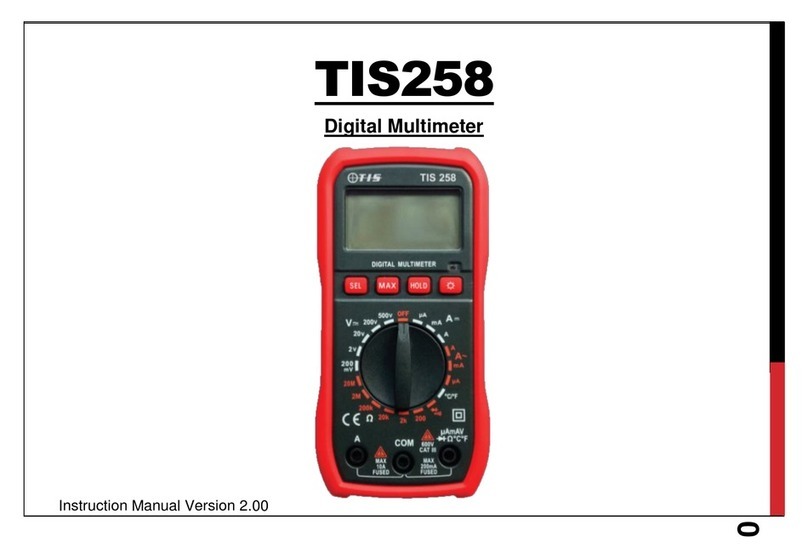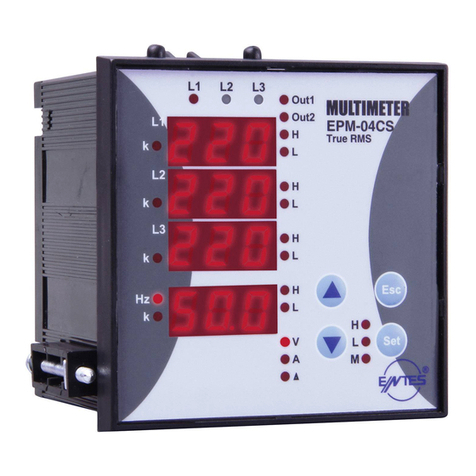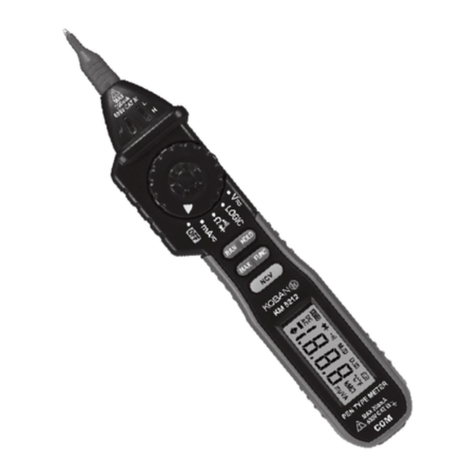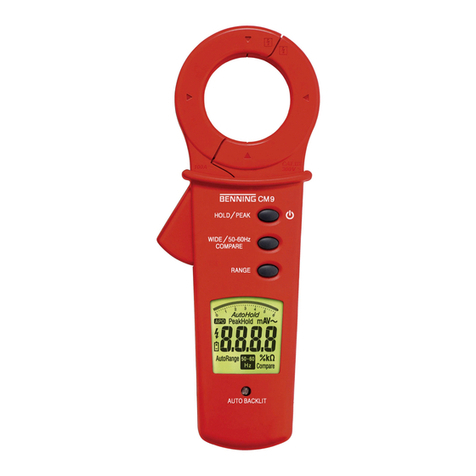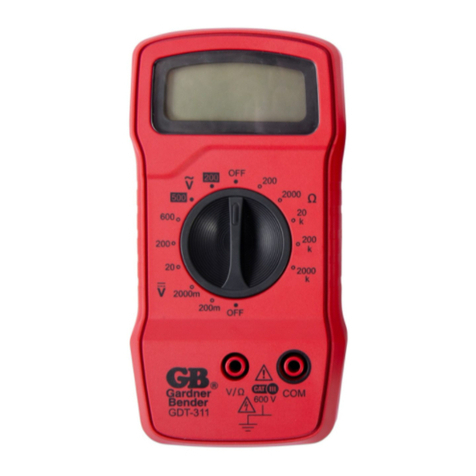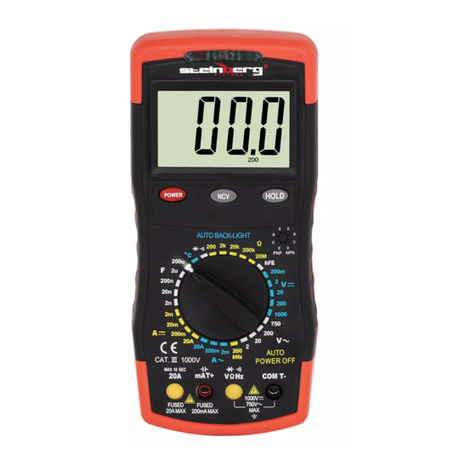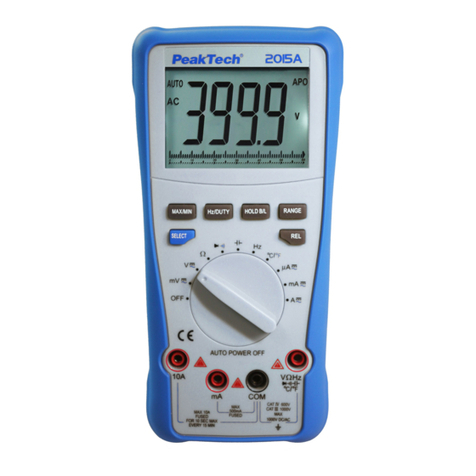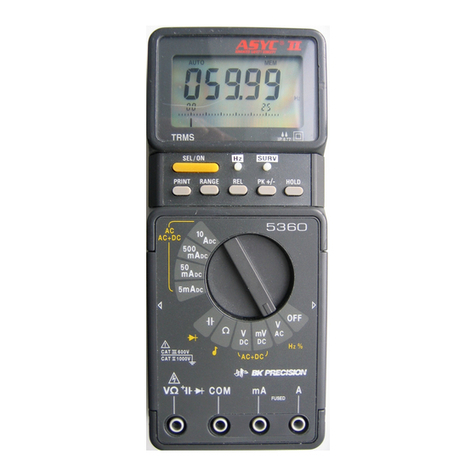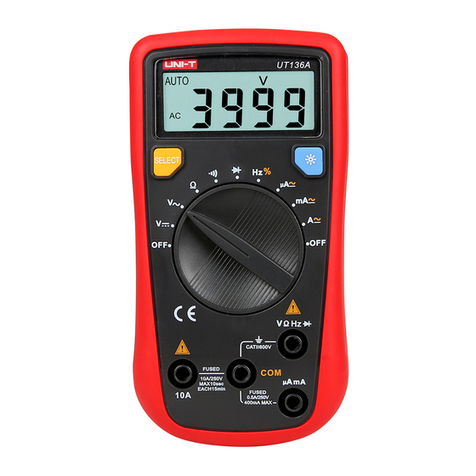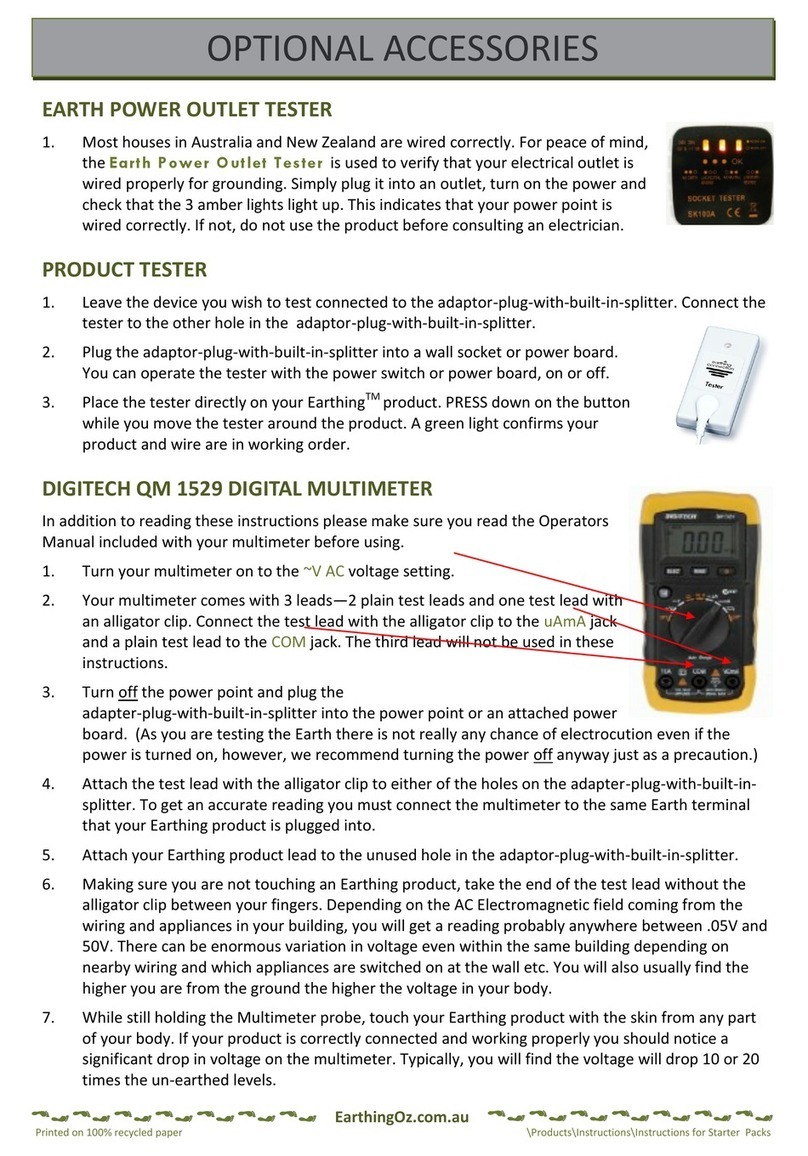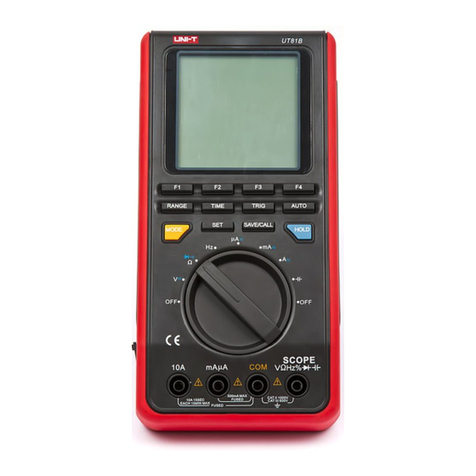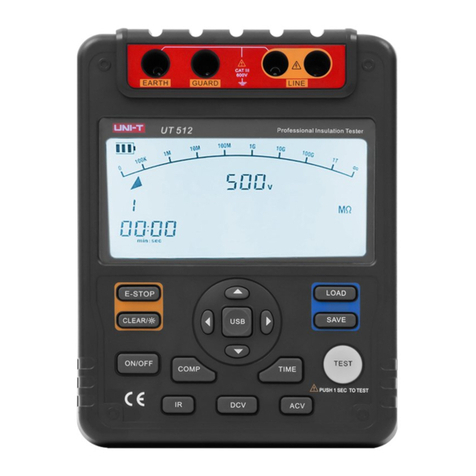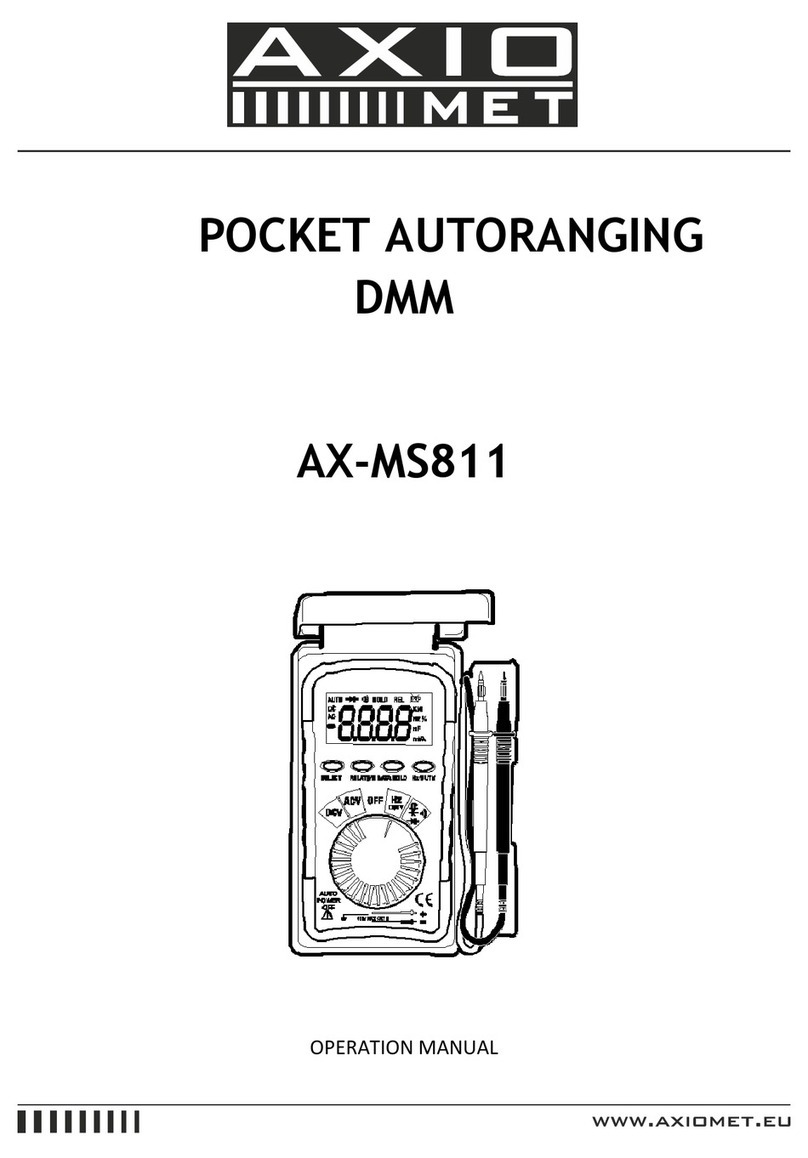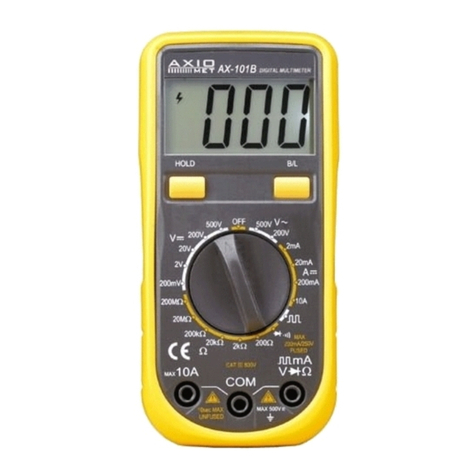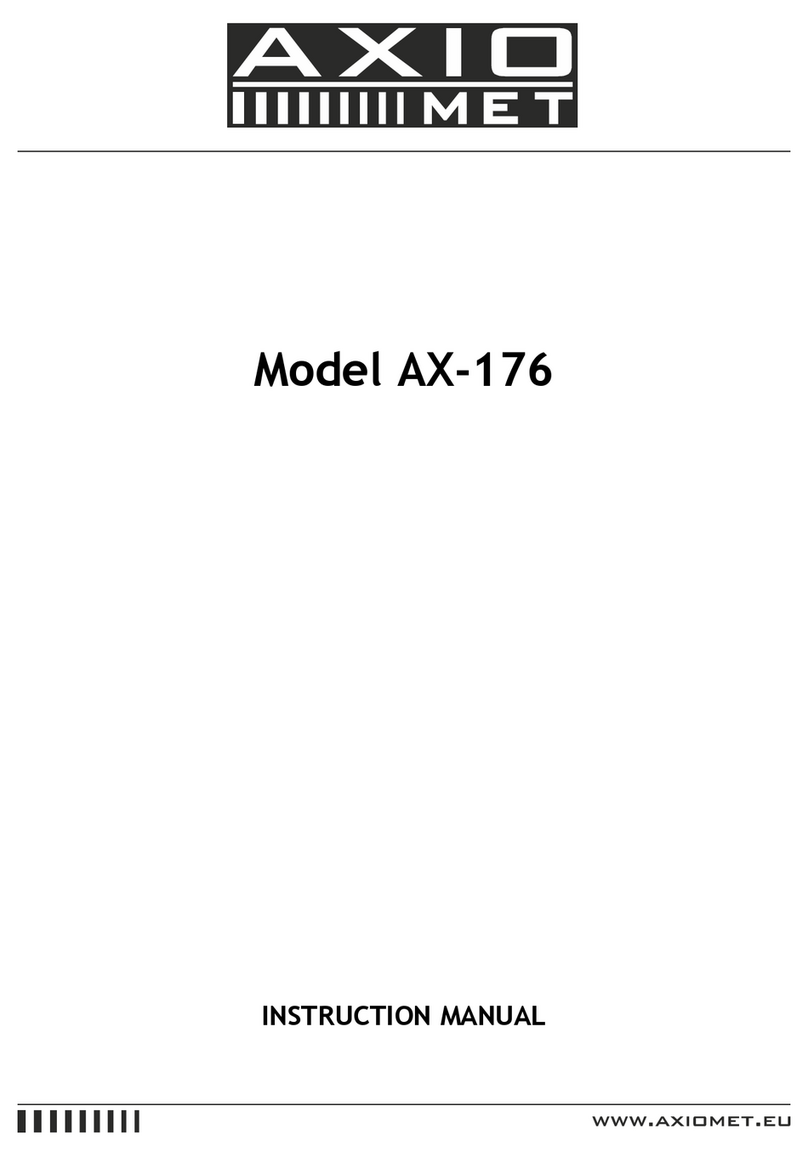TIS E217 User manual

USER'S
MANUAL
TIS E217

1
1) SAFETY
This manual contains information and warnings that must be followed for operating the meter
safely and maintaining the meter in a safe operating condition. If the meter is used in a
manner not specified by the manufacturer, the protection provided by the meter may be
impaired.
Terms in this manual
WARNING identifies conditions and actions that could result in serious injury or even death
to the user.
CAUTION identifies conditions and actions that could cause damage or malfunction in the
instrument.
WARNING
To reduce the risk of fire or electric shock, do not expose this product to rain or moisture.
The meter is intended only for indoor use.
Keep your hands/fingers behind the hand/finger barriers (of the meter and the test
probe assembly, where applicable) that indicate the limits of safe access of the hand-
held parts during measurements. Inspect lead wires, connectors, and probes for
damaged insulation or exposed metal periodically. If any defects are found, replace
them immediately. Optional offer, at agent’s discretion, premium test probe assembly
silicon wires equip with white inner insulation layer as wear indicator. Do not use them
if the wear indicator has become visible. Only use the probe assembly provided with
the meter or a UL Listed Probe Assembly to the same meter ratings or better.
IEC 61010-031 requires exposed conductive test probe tips to be ≤4mm for CAT III & CAT
IV ratings. Refer to the category markings on your probe assemblies as well as on the add-
on accessories (like detachable Caps or Alligator Clips), if any, for applicable rating changes.
Observe proper safety precautions when working with voltages above 30 Vrms, 42.4 Vpeak
or 60 VDC. These voltage levels pose a potential shock hazard to the user. Before and after
hazardous voltage measurements, check the voltage function on a known source such as
line voltage to determine proper meter functioning.
CAUTION
Disconnect the test leads from the test points before changing functions.

2
International Electrical Symbols
Marking of Electrical and Electronic Equipment (EEE). Do not dispose of this
product as unsorted municipal waste. Contact a qualified recycler
Caution! Refer to the explanation in this Manual
Caution! Possibility of electric shock
Earth (Ground)
Meter protected throughout by Double Insulation or Reinforced insulation
Fuse
Direct Current (DC)
Alternating Current (AC)
3Three-phase Alternating Current
Brief Information about Measurement Categories
Measurement Category IV is applicable to test and measuring circuits connected at the
source of the building’s low-voltage MAINS installation. Examples are measurements on
devices installed before the main fuse or circuit breaker in the building installation.
Measurement Category III is applicable to test and measuring circuits connected to the
distribution part of the building’s low-voltage MAINS installation. Examples are
measurements on distribution boards (including secondary meters), circuit-breakers, wiring,
including cables, bus-bars, junction boxes, switches, socket-outlets in the fixed installation,
and equipment for industrial use and some other equipment such as stationary motors with
permanent connection to the fixed installation.
Measurement Category II is applicable to test and measuring circuits connected directly to
utilization points (socket outlets and similar points) of the low-voltage MAINS installation.
Examples are measurements on MAINS CIRCUITS of household appliances, portable tools
and similar equipment.
2) CENELEC DIRECTIVES
The instruments conform to CENELEC Low-voltage directive 2014/35/EU,
Electromagnetic compatibility directive 2014/30/EU and RoHS directive 2015/863/EU.

3
3) PRODUCT DESCRIPTION
Note: Top of the line model is used as representative for illustration purposes. Please refer to
your respective model for function availability.
1) 3-5/6 digits 6000 counts
LCD display
2) Push-buttons for special
functions & features
3) Selector to turn the Power
On or Off and Select a
function
4) Input Jack for 10A (20A for
30sec) current function
5) Input Jack for all functions
EXCEPT 10A current
function
6) Common (Ground
reference) Input Jack for all
functions
7) Additional input Jack for
Phase Rotation function only

4
True RMS
RMS (Root-Mean-Square) is a term used to describe the effective or equivalent DC value of
an AC signal. True RMS is the term which identifies a DMM that responds accurately to the
effective RMS value regardless of the waveforms such as: square, sawtooth, triangle, pulse
trains, spikes, as well as distorted waveforms with the presence of harmonics. Harmonics
may cause :
1)Overheated transformers, generators and motors to burn out faster than normal
2)Circuit breakers to trip prematurely
3)Fuses to blow
4)Neutrals to overheat due to the triplen harmonics present on the neutral
5)Bus bars and electrical panels to vibrate
Crest Factor
Crest Factor is the ratio of the Crest (instantaneous peak) value to the True RMS value, and
is commonly used to define the dynamic range of a True RMS DMM. A pure sinusoidal
waveform has a Crest Factor of 1.414. A badly distorted sinusoidal waveform normally has a
much higher Crest Factor.
4) OPERATION
CAUTION
Before and after hazardous voltage measurements, test the voltage function on a known
source such as line voltage to determine proper meter functioning.

5
AutoV (LoZ) mode
AutoV automatically selects measurement function of DCV or ACV, based on their input
levels via the test leads. The input also provides a low ramp-up impedance (LoZ) to drain
ghost voltages*.
●With no input, the meter displays “- - - -” when it is ready.
●When a signal above the voltage threshold of 1V DC or AC up to the rated 1000V is
present, the meter displays the voltage value in appropriate DC or AC, whichever larger in
peak magnitude.
Note:
*Ghost-voltage Buster: Ghost-voltages are unwanted stray signals coupled from adjacent
hard signals, which confuse common multimeter voltage measurements. The AutoV mode
provides low (ramp-up) input impedance (approx. 2.1kΩ at low voltage) to drain ghost
voltages leaving mainly hard signal values on meter readings. It is an invaluable feature for
precise indication of hard signals, such as distinguishing between hot and open wires (to
ground) in electrical installation applications.
*Only HOLD, EF & Backlight push-button features are available in AutoV mode.

6
WARNING:
AutoV mode input impedance increases abruptly from initial 2.1kΩ to a few hundred kΩ’s
on high voltage hard signals. “LoZ” displays on the LCD to remind the users of being in such
low impedance mode. Peak initial load current, while probing 1000VAC for example, can be
up to 673mA (1000V x 1.414 / 2.1kΩ), decreasing abruptly to approx. 2.4mA (1000V x 1.414
/ 580kΩ) within a fraction of a second. Do not use AutoV mode on circuits that could be
damaged by such low input impedance. Instead, use rotary selector or high input
impedance voltage modes to minimize loading for such circuits.
ACV, DCV & VFD-ACV functions
Press the SELECT button momentarily to select the subject functions in sequence. Last
selection will be saved as power up default for repeat measurement convenience.
Note:
VFD-ACV and the associated Hz are equipped with digital low-pass filter (DSP), and are
capable of handling VFD (Variable Frequency Drives) signals for fundamental V & Hz
readings. It also improves ACV and Hz reading stability when being used in most noisy
electrical environments.

7
Line Frequency functions
Press the Hz push-button momentarily to toggle Hz function. It is only available to Voltage
and Current related ranges.
Input sensitivity varies automatically with the function range selected while activating the Hz
function. 6V function range has the highest and the 1000V range has the lowest. When
activated under DCV, ACV or VFD-ACV voltage function, the trigger voltage range will be
displayed right before starting the Hz readings. Press momentarily the RANGE button can
manually select another trigger voltage range (not available to current ranges). It is
recommended to first measure the signal voltage (or current) level and activate Hz function
in that range to get the most appropriate trigger level. If the Hz reading becomes unstable,
select lower sensitivity to avoid electrical noise. If the reading shows zero, select higher
sensitivity.
Resistance, BeepLitTM Continuity & Diode;
Capacitance
Press the SELECT button momentarily to select the subject functions in sequence. Last
selection will be saved as power up default for repeat measurement convenience.

8

9
BeepLitTM Continuity function is having improved convenience for checking wiring
connections and operation of switches. A continuous beep tone together with flashing
display backlight indicate a complete wire. Such audible and visible indications improve
continuity readabilities in noisy working environments.
In Diode function, the normal forward voltage drop (forward biased) for a good silicon diode
is between 0.400V to 0.900V. A reading higher than that indicates a leaky diode (defective).
A zero reading indicates a shorted diode (defective). An OL indicates an open diode
(defective). Reverse the test leads connections (reverse biased) across the diode. The digital
display shows OL if the diode is good. Any other readings indicate the diode is resistive or
shorted (defective).
CAUTION
Using resistance and continuity function in a live circuit will produce false results and may
damage the instrument. In many cases the suspected component must be disconnected
from the circuit to obtain an accurate reading.
CAUTION
Discharge capacitors before making any measurement. Large value capacitors should be
discharged through an appropriate resistance load.
ACmV & DCmV; Temperature oC & oF
Press the SELECT button momentarily to select the subject functions in sequence. Last
selection will be saved as power up default for repeat measurement convenience.
Note: Be sure to insert the banana plug type-K temperature bead probe Bkp60 with correct
polarities. You can also use a plug adapter Bkb32 (Optional purchase) with banana
pins to type-K socket to adapt other standard type-K mini plug temperature probes.

10
A Current function
Press SELECT button momentarily to toggle between DC and AC.Last selection will be
saved as power up default for repeat measurement convenience.

11
A Current function
Press SELECT button momentarily to toggle between DC and AC.Last selection will be
saved as power up default for repeat measurement convenience.
Application notes for flame sensors:
DCAfunction is useful for HVAC/R flame sensor applications. The 0.1A resolution can
identify the minute current changes in flame detector applications. Flame signal current
check should indicate steady flame signal of at least 2A for a rectification type, or 1.5A for
an ultraviolet type (8A for self checking systems). If a flame signal current with inadequate
strength or fluctuation beyond 10%, check the following to avoid the risk of unwanted flame
relay dropout :
For gas or oil flames (Minipeeper):
Low supply voltage
Detector location
Defective detector wiring
Dirty viewing windows
Faulty Minipeeper
For oil flames (Photocell):
Detector location & wiring
Smoky flame or poorly adjusted air shutter
Faulty Photocell

12
Temperature over 165 oF (74 oC) at photocell
For gas flames (Flame Rod):
Ignition interference (A flame signal current difference with the ignition both on and off
greater than 0.5A indicates the presence of ignition interference)
Insufficient ground (must be at least 4 times the detector area)
Flame lifting off burner head (ground), or not continuously in contact with the flame rod
Temperature in excess of 600 oF (316 oC) at the flame electrode insulator causing short
to ground.
Electric Field EF-Detection
Press the EF button momentarily to toggle EF-Detection feature. The meter displays “EF-H”
when it is ready. If it is too sensitive for your applications, press (Level) button momentarily
toggles to lower sensitivity “EF-L”. The detected Electric Field strength is indicated as a
series of bar-graph segments on the display plus variable beep tones.
●Non-Contact EF-Detection: An antenna is located along the top-left end of the meter,
which detects electric field surrounding energized live conductors. It is ideal for tracing live
wiring connections, locating wiring breakages and to distinguish between live and earth
connections.
●Probe-Contact EF-Detection: For more precise indication of live wires, such as
distinguishing between Live and Ground connections, use direct contact testing with one
single test-probe via the input terminal COM or V. The COM terminal (Black) has the best
sensitivity.

13
& 3-Phase Rotation function
Inputs are made via the test lead terminals L1/L2/L3. Phase Rotation directions are
indicated as symbolic movements by the LCD segments. Press SELECT button momentarily
toggles between and modes. Last selection will be saved as power up default for
repeat measurement convenience.
: Hi-sensitivity mode, which detects relatively low signal outputs generated from motor
spinning, for checking phase connections of Motors.
: Normal-sensitivity mode for identifying phase sequence of Electricity Supply.

14
CAUTION
Proper Rotation detection relies on solid signal connection to all three test lead terminals
simultaneously. Any single disconnection will lead to detection failure and may produce false
indication. To verify signal connection and hence proper meter indication, swap any two
connects (to the meter) to check for meter indication of reverse movement
Using the Hi-sensitivity mode for Motors:
Connect to the Motor as illustrated. Be sure the electricity supply is removed. From the
perspective of looking down the shaft of the motor, speed-spin it clockwise to generate
sufficient signal strength for proper meter detection. If the meter indicates a clockwise
movement, the motor leads connected to L1, L2 and L3 of the meter are L1, L2 and L3 (also
known as R, S and T) respectively. If the meter indicates a counter-clockwise movement,
swap any two connects between the meter and motor. Then retest.
Using the Regular-sensitivity mode for MAINS (Electricity Supplies):
Connect to the MAINS as illustrated. If the meter indicates a clockwise movement, the
phases connected to L1, L2 and L3 of the meter are L1, L2 and L3 (also known as R, S and
T) respectively. If the meter indicates a counter-clockwise movement, swap any two
connects between the meter and phases. Then retest. Connect the above mentioned L1, L2
and L3 of a Motor and that of the MAINS respectively should be able to get a clockwise
motor movement.
Using the Complementary Beeper feature:
The Complementary Beeper feature is selected in Power-up option. Press and hold the REC
button while turning the meter on to enable. If the segments indicate a clockwise movement,
the beeper sounds a single long beep per segment cycle. If the segments indicate a counter
clockwise movement, the beeper sounds 3 short beeps per segment cycle.
MAX/MIN/AVG Record mode
Press REC button momentarily to activate MAX/MIN/AVG recording mode. The LCD “MAX
MIN AVG”turn on. The meter beeps when new MAX (maximum) or MIN (minimum) reading
is updated. Press the button momentarily to read the MAX, MIN, AVG readings in sequence.
Press the button for 1 second or more to exit MAX/MIN/AVG recording mode. Auto-ranging
remains, and Auto-Power-Off is disabled automatically in this mode.
Backlighted LCD display
Press the SELECT button for 1 second or more to toggle the LCD backlight. The backlight
will also be turned off automatically after 10 minutes to extend battery life.

15
Hold
The hold feature freezes the display for later view. Press the HOLD button momentarily to
toggle the hold feature.
Relative Zero ( ) mode
Relative Zero allows the user to offset the meter consecutive measurements with the
displaying reading as the reference value. Practically all displaying readings can be set as
relative reference value including MAX/MIN/AVG feature readings. Press the button for
one second or more to toggle Relative Zero mode.
Manual or Auto-ranging
For most auto-ranging functions (LCD turns on by default), press the RANGE button
momentarily to select manual-ranging override. The meter will remain in the range it was in,
the LCD turns off. Press the button momentarily again to select the next range. Press
and hold the button for 1 second or more to resume auto-ranging.
Note: Manual-ranging feature is not available to AutoV, Capacitance & Hz functions.
Beep-Jack™ Input Warning
The meter beeps as well as displays “InEr” to warn the user against possible damage to the
meter due to improper connections to the A, mA, or A input jacks when another function,
especially a voltage function, is selected.
Intelligent Auto-Power-Off (APO)
The Auto-Power-off (APO) mode turns the meter off automatically to extend battery life after
approximately 32 minutes of no specified activities, where applicable:
1) Rotary switch or push button operations
2) Significant measuring readings of above 8.5% of ranges
3) Non-OL readings for Resistance, Continuity or Diode function
4) Non-zero readings for Hz function
5) Electric field signal present for EF function
6) Significant movement indication as in Phase Rotation functions
In other words, the meter will intelligently avoid entering the APO mode when it is under
normal measurements. To wake up the meter from APO, press the SELECT button
momentarily and release, or turn the rotary switch OFF and then back on. Always turn the
rotary switch to the OFF position when the meter is not in use
5) MAINTENANCE
WARNING
To avoid electrical shock, disconnect the meter from any circuit, remove the test leads from
the input jacks and turn OFF the meter before opening the case. Do not operate with open
case. Install only the same type of fuse or equivalent

16
Cleaning and Storage
Periodically wipe the case with a damp cloth and mild detergent; do not use abrasives or
solvents. If the meter is not to be used for periods of longer than 60 days, remove the battery
and store it separately
Trouble Shooting
If the instrument fails to operate, check battery, fuse, leads, etc., and replace as necessary.
Double check operating procedure as described in this user’s manual
Battery use:
1.5V AAA Size battery x 2
Fuse use:
Fuse F2 for A current input:
11A/1000V DC/AC, IR 20kA F fuse
or better; Dimension: 10 x 38mm
Battery and Fuse replacement:
Loosen the screw from the access
cover of the case bottom. Lift the
access cover. Replace the batteries
or fuse. Re-fasten the screw.
GENERAL SPECIFICATION
Display: 3-5/6 digits 6,000 counts
Update Rate: 5 per second nominal
Operating Temperature: -10oC to 45oC
Relative Humidity: Maximum relative humidity 80% for temperature up to 31oC decreasing
linearly to 50% relative humidity at 45oC

17
Altitude: Operating below 2000m
Storage Temperature: -20oC ~ 60oC, < 80% R.H. (with battery removed)
Temperature Coefficient: Nominal 0.15 x (specified accuracy)/ oC @ (-10oC ~ 18oC or 28oC
~ 45oC), or otherwise specified
Sensing: True RMS sensing
Ingress Protection: IP40
Pollution Degree: 2
Safety: Certified per IEC/UL/EN61010-1 Ed. 3.0, IEC/UL/EN61010-2-030 Ed. 1.0,
IEC/UL/EN61010-2-033 Ed. 1.0, IEC/UL/EN61010-031 Ed. 1.1 and the corresponding
CAN/CSA-C22.2 regulations to Measurement Categories:
CAT II 1000V, CAT III 600V and CAT IV 300V AC & DC
Transient Protection: 6.0kV (1.2/50s surge)
E.M.C. : Meets EN61326-1:2013
In an RF field of 3V/m:
Temperature function is not specified
Ohm function:
Total Accuracy = Specified Accuracy + 15 digits
Other functions:
Total Accuracy = Specified Accuracy
Performance above 3V/m is not specified
Overload Protection:
A: 11A/1000V DC/AC rms, IR 20kA, F fuse or better
V, AutoV & L3: 1100V DC/AC rms
mV, Ohm & others: 1000V DC/AC rms
Low Battery: Below approx. 2.5V
Power Supply: 1.5V AAA Size battery X 2
Power Consumption (typical): 3.2mA
APO Consumption (typical): 10A
APO Timing: Idle for 30 minutes
Dimension: 161*80*50mm L*W*H (With Holster)
Weight: Approx. 334 gm (With Holster)
Special Features: AutoV (LoZ); 3-Phase Rotation detection; VFD; BeepLit™Continuity;
Auto-ranging MAX/MIN/AVG Record; Backlighted LCD; Auto-ranging Relative Zero mode;
Display Hold; EF-Detection (NCV); BeepJack™ on A terminal
Accessories: Test lead set; Alligator clip set; Batteries installed; User’s manual; Banana
plug type-K thermocouple
Optional Purchase Accessories: BKB32 banana plug to type-K socket plug adaptor;
BMH-01 magnetic hanger; soft carrying pouch

18
Electrical Specification
Accuracy is given as (% of reading digits + number of digits) or otherwise specified @ 23oC
5oC
ACV & ACA accuracies are specified from 1 % to 100 % of range or otherwise specified.
Maximum Crest Factor <2:1 at full scale & <4:1 at half scale, and with frequency
components fall within the meter specified frequency bandwidth for non-sinusoidal
waveforms
AC Voltage
RANGE
Accuracy
50Hz ~ 60Hz
6.000V 1), 60.00V, 600.0V, 1000V
0.7% + 3d
45Hz ~ 440Hz
6.000V 1), 60.00V, 600.0V, 1000V
2.0% + 3d
Input Impedance: 10M, 54pF nominal
1)<5d non-zero residue may appear when backlight is on, which will not affect the
specified measuring range and accuracy
ACmV
RANGE
Accuracy
10Hz ~ 500Hz
60.00mV 1) 2), 600.0mV 3)
1.0% + 3d
500Hz ~ 800Hz
60.00mV 1) 2), 600.0mV 3)
2.0% + 3d
Input Impedance: 10M, 54pF nominal
1)<5d non-zero residue may appear when backlight is on, which will not affect the
specified measuring range and accuracy
2)Signal peak absolute values, including DC bias, less than 130mVpeak
3)Signal peak absolute values, including DC bias, less than 1300mVpeak
DC Voltage
RANGE
Accuracy
60.00mV, 600.0mV, 6.000V
0.3% + 2d
60.00V
0.4% + 2d
600.0V
0.2% + 2d
1000V
0.4% + 2d
Input Impedance: 10M, 54pF nominal

19
VFD_ACV (with Low Pass Filter )
RANGE
Accuracy 1)
10Hz ~ 100Hz (fundamental)
600.0V, 1000V
1.0%+3d
100Hz ~ 400Hz (fundamental)
600.0V, 1000V
10%+3d 2)
1)Not specified for fundamental frequency > 400Hz
2)Accuracy linearly decreases from 1% + 3d @100Hz to 10% + 3d @400Hz
AutoV_ACV
RANGE
Accuracy 1)
45Hz ~ 440Hz
600.0V, 1000V
2.0% + 3d
1)Not specified at <1VAC
Threshold: > 1VAC nominal
Approximate input impedance (//164pF) for reference:
At direct input 50Vac (typical) from quiescence:
>8M@ < 5.6Vac
22k@ 7Vac
12k@ 8Vac
2.6k@ 50Vac
At direct input >>50V (typical) from quiescence:
Initial impedance is approximately 2.3k. Impedance increases abruptly within a
fraction of a second as display voltage (hard signal) is much higher than 50V
(typical). End-up impedances vs display voltages typically are:
12k@100V
100k@300V
240k@600V
580k@1000V
AutoV_DCV
RANGE
Accuracy 1)
600.0V, 1000V
2.0% + 3d
1)Not specified at <1VDC
Threshold: > +1.0VDC or < -1.0VDC nominal
Approximate input impedance (//164pF) for reference:
At direct input 50Vdc (typical) from quiescence:
>8M@ < 8Vdc (Protection clamping threshold)
Table of contents
Other TIS Multimeter manuals
